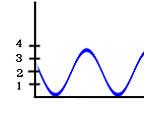 |
 |

|
|
Try this out! on this diagram
|
| In astronomy, amplitude of a light's wave is important because it tells you about the intensity or brightness of the light relative to other light waves of the same wavelength. It's a measure of how much energy the wave carries. | |
| So, if the light from Star A is brighter than the same type of light from Star B, you know that the light you see from Star A has the larger amplitude. Its very important to note that while amplitude gives you information about the intensity of the light, it is the wavelength, not the amplitude, that tells you what kind of light it is. | |
|
Remember, Wavelength tells you the type of light And, Amplitude tells you about the intensity of the light |
So, now you're ready to go ahead with the rest of the light tour! 
Copyright 1996 UC Regents


